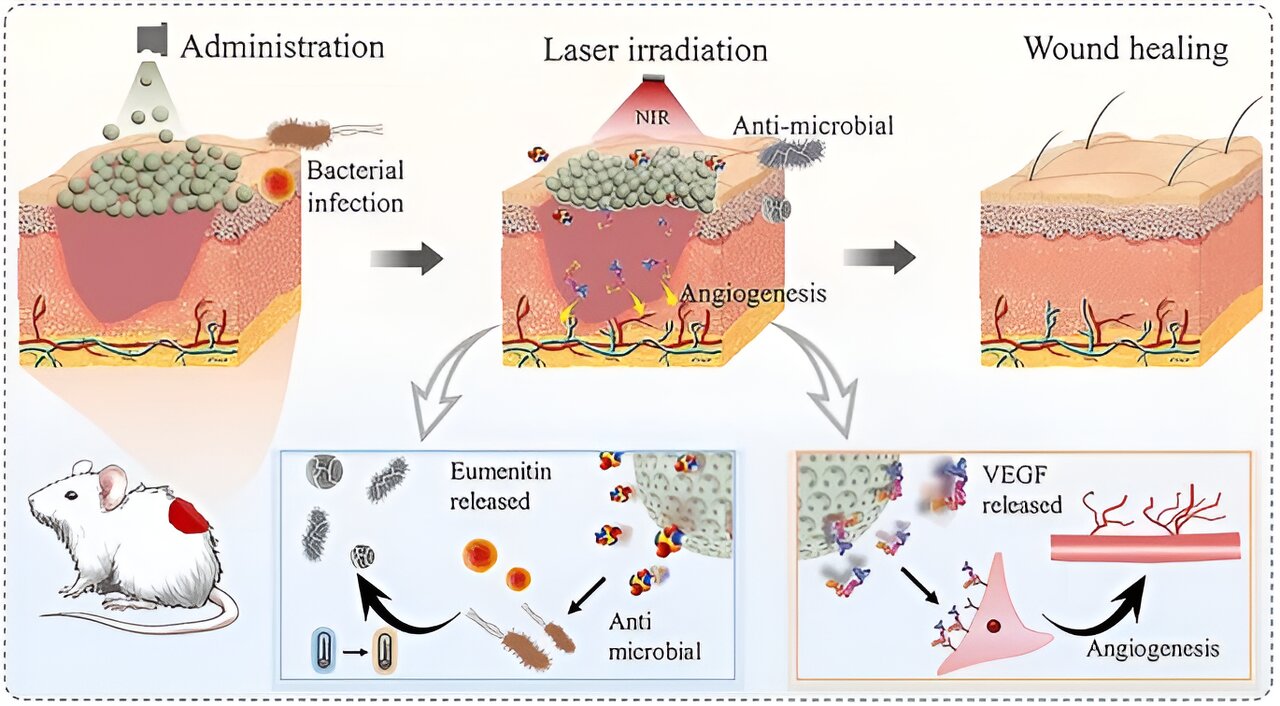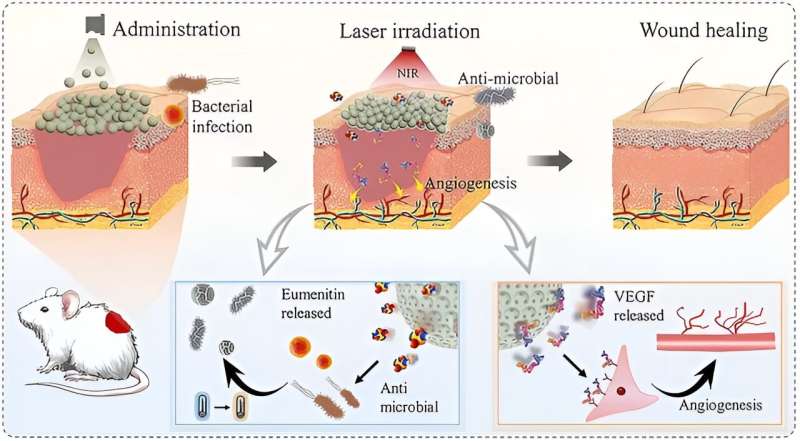

Chronic diabetic wounds are prevalent in patients and are difficult to heal, presenting a significant medical challenge. The development of multifunctional hydrogel dressings with a well-designed morphology and structure can enhance their flexibility and effectiveness in wound management.
Professor Hongbo Zhang from Åbo Akademi University in Finland and colleagues have proposed a self-healing hydrogel dressing based on structural color microspheres for wound management. Their research is published in the journal Nano-Micro Letters.
These microspheres are composed of an inverse opal framework with photothermal responsiveness, constructed from methacrylated hyaluronic acid, methacrylated silk fibroin, and black phosphorus quantum dots (BPQDs), and further embedded in dynamic hydrogels.
The dynamic hydrogel filler is formed through the Knoevenagel condensation reaction between cyanoacetate and benzaldehyde-functionalized dextran (DEX-CA and DEX-BA). Notably, the composite microspheres can be freely applied and, by utilizing the BPQD-mediated photothermal effect and the thermoreversible stiffness change of the dynamic hydrogel, can adhere to each other under near-infrared irradiation.
In addition, the microspheres are co-loaded with melittin and vascular endothelial growth factor, with a release behavior that can be regulated through the same mechanism. Additionally, the drug release process can be effectively monitored through visual color changes. This microsphere system demonstrates ideal capabilities in controlled drug release and efficient wound management.
Zhang and colleagues evaluated the in vivo wound healing efficacy of composite microspheres (CMPs) in a full-thickness chronic diabetic wound infection model. The diabetic model in Sprague-Dawley (SD) rats was established through intraperitoneal injection of streptozotocin (STZ).
Following the stabilization of blood glucose levels, circular full-thickness skin wounds were created on the dorsal area of the rats. Subsequently, various interventions were administered to different groups of rats to assess the effectiveness of CMPs in promoting wound healing.
Statistical analysis of wound closure areas and regenerated epithelial thickness revealed that the group treated with the dual-drug-loaded CMPs combined with near-infrared (NIR) irradiation exhibited superior wound healing outcomes, significantly outperforming other groups. These results suggest that the synergistic effects of NIR-controlled irradiation and the intelligent responsiveness of CMPs play a crucial role in enhancing wound healing.
Bacterial infection is a major cause of delayed healing in chronic wounds. The research team performed Masson’s trichrome staining to evaluate collagen deposition at the wound site. In the drug-loaded CMPs group, collagen arrangement and density were more pronounced, with increased collagen formation, confirming the CMPs’ ability to promote extracellular matrix deposition.
Neovascularization also plays a critical role in wound repair. To investigate the impact of VEGF (vascular endothelial growth factor) on wound healing, immunofluorescence staining for CD31 was employed to characterize newly formed blood vessels. Fluorescence images revealed fewer CD31-positive areas in the control group, whereas the CMPs@AMP&VEGF + NIR group exhibited the highest CD31 expression.
More information:
Li Wang et al, Self-Healing Dynamic Hydrogel Microparticles with Structural Color for Wound Management, Nano-Micro Letters (2024). DOI: 10.1007/s40820-024-01422-4
Provided by
Shanghai Jiao Tong University Journal Center
Citation:
Color-changing, self-healing hydrogel microparticles: A smart solution for advanced wound care (2024, September 3)
retrieved 3 September 2024
from https://phys.org/news/2024-09-hydrogel-microparticles-smart-solution-advanced.html
This document is subject to copyright. Apart from any fair dealing for the purpose of private study or research, no
part may be reproduced without the written permission. The content is provided for information purposes only.